|

[ Project Plans | Essential
Questions | Knowledge Hunt | Glossary | Links ]
Great Journeys - Maps of a Maverick
Creating Mind Maps and "Historical Maps" to Understand
the Scope of a Maverick's Journey
Introduction
Students need to analyze issues and problems from the past and
place the people and events within a context of time and place.
Students will need to understand and critically assess the economic
competition relating to the North American fur trade by exploring
how different groups interacted with each other as participants
in that industry. Why did Europeans come to the West? How did they
interact with the First Nations? What would have been difficult
about a journey like this?
Project Explanation
In this project, students will create two types of "maps,"
a mind map and a historical map, which will help them to understand
and appreciate the journey of an Uninvited Guest Maverick. They
will conduct research through the creation of a mind map using a
program such as Inspiration. Then they will take that research and
create their own "historical" map that outlines and
details the journey of the Maverick.
Alberta Social Studies Curriculum Unit Connections
Grade Four - Alberta: The Land, Histories and Stories
4.1 Alberta: A Sense of the Land
4.2 The Stories, Histories and People of Alberta
4.3 Alberta: Celebrations and Challenges
Grade Five - Canada: The Land, Histories and Stories
5.1 Physical Geography of Canada
5.2 Histories and Stories of Ways of Life in Canada
5.3 Canada: Shaping an Identify
Grade Seven - Canada: Origins, Histories and Movement of People
7.1 Toward Confederation
Materials and Resources Needed
Procedures
Students will create two kinds of maps, a mind map about the Maverick's
life and a historical political boundary map, similar to what David
Thompson would have created, detailing the travels of the Maverick
through their lifetime.
Individually, or in small groups, students will choose an Uninvited
Guest Maverick from the Mavericks: An Incorrigible History of
Alberta site to research and represent. They will use mind-mapping
software such as Inspiration to record any significant and relevant
information that will tell the story of the life of that person.
Headings that might be included are:
- What personal facts do we need to know?
- Who were the key people in their life?
- What important events did they participate in?
- What are their accomplishments?
- Where and when did they travel?
- What physical barriers, obstacles, or obstructions did they
face as they traveled?
- What difficulties did they encounter?
- What organizations were they affiliated with?
- What was happening in the world around them?
- Why are they are a Maverick?
Under each heading, students will add notes from their research,
using a limited number of words to get the main idea rather than
full sentences. This forces them to think about the right choice
of words and their importance. Balloons may be grouped according
to colours or graphics may be used for each section. Using clip
art graphics may help to convey the specific idea the students want
to express. Above all, the students can be creative in their approach
to the map. They may choose the headings, titles, notes, and graphics
that are relevant to their historical figure.
Once their mind-maps are complete, the students will create a "biographical"
political boundary map that represents the travels and journey of
the maverick throughout their lifetime. They will have to choose
the appropriate areas to represent, an appropriate scale, a legend,
as well as colour and labels to allow for others to understand its
"content" as easy as possible. Viewers should be able
to easily able to follow the journey of that Maverick by following
colour, dates, or other formats. Students could also label and explain
the major events that took place along the journey along the map.
Students may choose to either show the journey along a modern looking
map or use the historical maps on the Mavericks: An Incorrigible
History of Alberta site to create a map that would be historically
accurate for when the Maverick lived. They could use brown paper,
roughing it up when completed, to make it look used and antiquated.
Once completed, students should reflect on their Mavericks journey
by comparing how we might make a similar journey today. What would
have been difficult about undertaking such a journey back then?
What would you need to think about in planning such a journey? Are
there any journeys into new territory that we may embark on today?
Assessment and Evaluation
- After the teacher and students collaboratively create a rubric,
students should use it as a guide for their learning as they are
working through the process, regularly checking that all the needed
elements are included in their work and revising as needed. The
rubric can then be used as a formal evaluative tool when they
have completed their project.
- Students may use the project rubric as a guide for writing a
self-assessment of their project work. They will determine their
level for each of the categories and use the criteria specified
in their rubric to justify them.
- A project journal may be used for information gathering as well
as for reflective writing as the process is taking place. Students
can pose questions, vent frustrations, synthesize their work,
examine their process, and even wonder about what they are missing
or what is still needed for their project. This may be completed
as a group or individually.
Ideas for Enriching this Project
- Students could compare historical maps to modern political boundaries,
noting the changes that have taken place since the time of the
original map.
- Students could examine how a mapmaker like David Thompson would
create maps before the creation of satellites. How did they make
the maps? What tools did they use? How accurate were they?
 |



![]()
